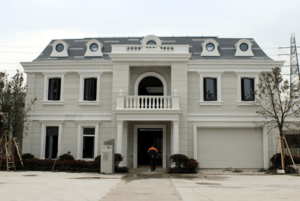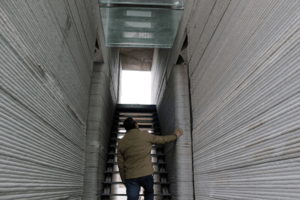Additive Manufacturing: Potential Solution to the Labor Shortage in Construction

Additive Manufacturing’s Importance
Despite a recovery from the Great Recession of 2008-2009, productivity in the construction sector lags behind many other segments of the economy. According to a McKinsey Global Institute paper, world manufacturing productivity has increased an average of 3.6% per year over the past 20 years while construction productivity has grown 1% or less during the same time period. The average construction project is completed 20 months behind schedule, and 80% of projects are completed over budget.1.
In the United States, one factor causing construction’s productivity lag is dearth of workers. The Associated General Contractors of America found 86% of its members reported a shortage of labor when trying to staff construction projects.2 Such worker shortages are projected to persist or increase due to an aging construction labor force, phasing out of traditional high school shop classes, continued enforcement of laws targeting illegal immigration, and a shunning of construction jobs in favor of college and white collar work by the millennial generation.1,2
New technology may ease problems due to labor shortages. Specifically, several early stage companies have been using additive manufacturing to construct everything from pedestrian bridges to housing and office space. Additive manufacturing relies on either no or greatly-reduced human labor because it uses automated printing machines to overlay materials layer-by-layer in the construction process. While additive manufacturing has several hurdles to overcome before widespread adoption, traditional construction firms are taking notice of its potential benefits, particularly when it comes to addressing worker shortages.
AECOM
AECOM is a global infrastructure firm that specializes in consulting, construction, and management services. Projects include Georgia Institute of Technology’s undergraduate learning center; One Bryant Park, a 2.1 million square foot office tower in New York City; and Metropolis, a $1.2 billion mixed-used development in Los Angeles.3 In May of 2017, AECOM entered into a Memorandum of Understanding with Yingchuang Building Technique Co. Ltd (known as Winsun), a little-known Chinese construction 3D printing company. Ian Chung, senior vice president of AECOM, described the agreement: “The potential for 3D printing to transform the infrastructure industry is still largely untapped and we are excited by the prospect of introducing this capability…to help our global network of clients achieve faster turnaround times.”4

Winsun has been creating houses using additive manufacturing since 2013, and the 3D printing method has facilitated faster construction using less labor. For example, construction of a 1,100 square meter, two-story house took one day to print, two days to assemble, and required only three laborers. The company built a 2,700 square foot office building in Dubai in 17 days at a cost of $140,000. The process uses primarily mine tailings combined with proprietary additives for its “ink” and, according to Winsun, produces virtually zero waste.5 By joining forces with Winsun, AECOM is able to dabble in the additive manufacturing space without making large investments in the technology itself. In the short-term, AECOM should consult with Winsun to identify uses for 3D printing in AECOM’s current or near-term projects. These could include straight-forward uses like precast molds, overhangs, folds, and insulations. Given AECOM’s size, it should consider acquiring Winsun or additive manufacturing technology itself in the longer term, as the market matures.

While additive manufacturing possesses significant benefits, especially in terms of minimizing required labor and speeding construction, the technology faces several obstacles. In the medium term, AECOM would be wise to use its extensive experience and resources to address some of these challenges. One such obstacle is persistent skepticism in the design community regarding the viability of 3D printing.6 AECOM has an established reputation among designers and engineers worldwide. Its use of the technology could go a long way in refuting skepticism. Development has several other costs, beyond just construction, that have made it difficult for some startups to create dwellings at the cheaper price points promised by 3D printing. These include entitling land and bringing utilities to the site.7 AECOM has experience in these activities, and its partnership with Winsun will allow the two to leverage these capabilities, speed the construction process, and take full advantage of additive manufacturing’s benefits.
AECOM has positioned itself as an early adopter of additive manufacturing technology through a partnership with Winsun. Such technology can help insulate AECOM from future challenges in construction, especially continued labor shortages and delays in project completion. Conversely, AECOM can help Winsun overcome some of the early obstacles facing 3D printing and legitimize the technology’s wider use.
Open Question
- Governments have not updated their regulatory regimes to reflect the use of additive manufacturing in construction. Is it wise for large firms like AECOM to push forward before this regulatory uncertainty is resolved?
(771 words)
Sources
- Bughin J, Manyika J, Woetzel J. Reinventing Construction: A Route to Higher Productivity. McKinsey Global Institute (February 2017).
- The Associated General Contractors of America. 2015 Workforce Survey National Results. 2015, https://public-gazfnvk.netdna-ssl.com/wp-content/uploads/sites/4/2015/11/2015_Workforce_Survey_National.pdf?x64028
- AECOM Corporate website. Projects. https://www.aecom.com/projects/
- Lam, Rebecca. “AECOM signs Memorandum of Understanding with Winsun to collaborate on 3D printing for building design and construction.” PR Newswire, May 2017. https://en.prnasia.com/releases/apac/AECOM_signs_Memorandum_of_Understanding_with_Winsun_to_collaborate_on_3D_printing_for_building_design_and_construction-177952.shtml
- Future of Construction. Winsun. https://futureofconstruction.org/case/winsun/
- “Winsun: Demonstrating the Viability of 3D Printing at Construction Scale.” The World Economic Forum, 8 December 2016.
- Luck, Marissa. “3D printing could revolutionize homebuilding, but here’s what has to happen first.” Austin Business Journal, 25 May 2018.



Thanks for the post, Sterling. I think if AECOM is comfortable with how additive manufacturing can impact the residents and structural integrity and avoid the ‘danger zone’, it should proceed with these projects. I see two large potential benefits in doing so: (1) AECOM can help provide more affordable supply to a high demand market, hopefully alleviating some of the housing pressure across the world, and (2) AECOM can use its learning to help guide the formation of intelligent and experience-based regulation. By taking the lead and pioneering this arena, AECOM can provide value on a number of fronts across consumers, technology and government.
Printing houses certainly would be something else… I think this idea has many ramifications within the labor force. While on face value it appears to be good in that it addresses a labor shortage and the associated time delays and cost overruns, I share some of your concerns about the long term implications. As I understand it, there are still serious material questions surrounding AM components, particularly within metals and directly linked to the manner in which these materials are ‘printed’ – whether via melting of metal particles by laser or some other method. This has numerous implications on how high an AM building can be, how strong it is and where it can be (i.e. can it stand up to hurricanes, tornadoes, earthquakes, etc), and what is the lifetime of the building. Additionally, I would anticipate there to be a strong backlash from workers, especially since many construction workers are still consolidated into unions. Looking ahead, I see a lot of head butting between government, corporations, and workers/voters delaying the introduction of AM into the main thrust of construction projects. Lastly, homes and buildings are people spaces at their core. From what I have seen of AM constructed homes so far, they appear ‘additive’ in nature, by which I mean, they look like a child at the beach layered them in their construction. I am not sure this will resonate with people without having a component of labor still attached to construction to make these places live-able and/or work-able.
Great article – I imagine that to get scale, AECOM should focus on a single style of construction that they can prove out. However, this could reduce their flexibility and limit the potential applications. I worry about the regulatory question you raised at the end. Zoning rules vary slightly by municipality, and I wonder to what extent you would still need human workers as a follow on to still build the building.
Great read! I do think AECOM should be concerned about regulation, and also the perspective of insurance companies on 3D printed houses/office buildings. Similar to autonomous vehicles, I think insurance can pose a similar problem: would companies be willing to cover houses that are 3D printed? Who is liable if the house collapses or has any other structural damage – would the 3D printing company themselves have to share in the cost? Lots left to be answered in this space but very exciting to hear about its development!
Given the increasing labor shortage in the construction industry and the rising need for infrastructure in emerging markets, I definitely see a rise in the value that additive manufacturing brings to the construction industry. I recently wrote a similar piece and posed the same question you asked. How do we get the bureaucrats to swiftly move into the action of determining the safety of this process and adaptation into law once verified?
Upon reflection, my thought is that the early adopters should be involved in educating the public not only about the benefits to the construction industry but educating the public about the safety it brings. I believe the public conviction can go a long way towards motivating the government to validate the efficacy of this manufacturing process and potentially pass it into law.
Great article! I think this technology has the potential to disrupt the construction and real estate market. Due to significant cost reductions, I believe it could be especially valuable for the affordable housing market.
On the legislation factor, I would argue for the company to try to get buy-in from the government and the engineering boards before it goes on. Differently from ridesharing apps, construction companies usually have projects that depend on public financing or are contracted by the government itself. In this context, ignoring current legislation could generate backlash from the government and prevent 3D printing adoption.